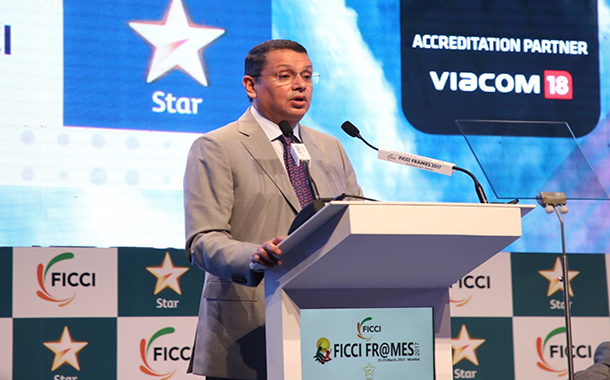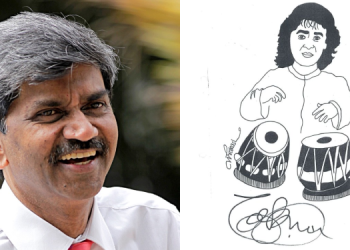Mr Uday Shankar, Chairman, FICCI Media & Entertainment Committee and Chairman & CEO, Star India has delivered his theme Address at the FICCI FRAMES 2017.
While speaking on the theme of this year’s FICCI Frames “Are we going to see a digital divide or a digital dividend?” he said, “I am sure we will hear a lot from all of you in the next couple of days but personally I find predicting the future to be a tricky business -especially when it involves adoption of new technology”.
Mr Shankar has optimistic about the growth story of digital in M&E sector, ever though the Start up story of India is no that encouraging. Recalling the last year’s scenario he said, “Just a year ago, at this very venue, there was a lively discussion on digital adoption. In less than a year, we are past that tipping point in this country. The distance that India has travelled in adopting internet based behavior is nothing short of remarkable. From buying goods and services to ordering in, we seem to have done it forever. India is now one of the largest markets for mobile applications – be it by volumes of downloads, consumption of video or e-commerce, for which it has already emerged as the next frontier. On the other hand, the conversation last year was about how many more unicorn start-ups will we see; this year it is about how many lame horses will have to be put down. Fortunately, the digital story for the M&E sector continues to look exciting and it is already the next big destination for the global digital giants like Netflix and Amazon Prime.”

He had his appreciation for home-grown digital enterprises and said, “The stories of bottomless war-chests may or may not be hyperbole, but, it does give us a sense of the competition that they see from home-grown digital enterprises like Hotstar, Voot and the others. If there is one thing we know for sure, it is that this year we will see a lot more lively activity on this front. The technology, that some of us have introduced in this country is as good if not better than the best in the world. Combined with the reset in costs and quality benchmarks led by Reliance Jio, this has driven the adoption by the Indian consumer at a breathtaking pace”.
He also expressed his anguish over the censorship and fundamentalist fringe elements obstructing the Creativity and involving in vandalism and said, I am concerned if the Indian creative mind is in a position to respond to the pace of technological change with an equally rapid evolution in its creativity. The key reason for this is of course the censorship that we all have to put up with. As the world gets bolder, our censor authorities seem to be getting more and more conservative. Even a word like ‘saali’ has to be silenced in a film. The city names must be absolutely correct and contemporary and of course don’t go anywhere near discussions of women’s issues – let alone female sexuality. I understand that in 2015-16 the censor board refused certification to 77 movies. This number was 47 in 2014-15 and only 23 in the year before. But can we lay all the blame on the board itself? In my view the board generally reflects the dominant consensus of our society and there are increasingly more bodies, mostly self-appointed, who have taken upon themselves the task of censoring media content. The refrain seems to be – I don’t like the legend or the myth on which your story is based, so I will burn down your sets. I don’t like a character, so I will not let you release your film. If you say you are going to do a show of busting fake godmen and gangsters, there is pre-emptive action. And what is becoming alarming now is that sometimes even the forums that you would seek redressal at are more inclined to bless the street side censorship than speak for the freedom of expression”.
He took an example of the movie ‘Jolly LLB – 2’ to justify his anguish as few days before the release of the movie they were asked to screen it to a group of lawyers and medical professionals and questioned who were they to decide whether the scenes were appropriate or whether they insulted any profession or institution, despite the fact that the movie had been certified for universal release by the censor board.
He accused that the creative community has been bullied into changing its output to suit the needs of someone or the other in India.
While throwing his opinion on the verdict on the Complusary National Anthem issue he sadi, “The institutions tasked with protecting expression and plurality, seem to be at loggerheads with the objective itself. By creating elaborate formal ceremonies around it, are we taking the joy out of one of the most loved and celebrated lyrics in our country i.e. our National Anthem? What’s frightening is that the court order has just become yet another weapon in the hands of any goon who is keen to stamp his authority. We are rapidly descending into a mindset where the most critical objective of a work of art is to make sure that it offends nobody no matter how many thematic or creative compromises it has to make. This is the most worrying part – that creative minds have begun to self-censor their thoughts and have started killing ideas before they germinate so as to avoid any conflict. And that is really frightening. The advocates of this vandalism claim that unique measures must be taken to protect our unique culture”.
He also compared the current scenario in India on par with the a similar scenario in Hollywood in early part of 20th Century that resulted in Television becoming popular among masses and said, “Let me tell you there is nothing unique about these methods. We seem to be following the script that Hollywood had written almost 100 years ago. In the early part of the 20th century, Hollywood had decided to self-regulate itself. It adopted a production code and insisted on its enforcement for almost 25 years. The code covered the use of profanity like hell and damn, any suggestive nudity, wilful offense of any nation, race or creed and any ridicule of the clergy among other things”.
“Doesn’t it sound familiar? The similarity with our own moral code is striking to say the least. Interestingly, television that was just arriving in American homes then, emerged as the challenger to this regime. Along with European cinema that came into the US, television buried this regressive moral code”.
Finally, He concluded that the regulation imposed on the creativity will result in the birth of content revolution in Digital Media and said, “The question today is – will digital play the same role for our generation and our country? The role of a progressive challenger, the role of providing a bigger canvas to creativity and creating a space for dissenting points of view. This new medium has the ability to truly democratize broadcasting.”
“It offers the creative community the rare opportunity to rethink from scratch their art and how it is communicated. Only when modern technology and contemporary creativity truly come together, will we create a compelling and powerful media and entertainment offering”
The content was from the Theme Address delivered by Mr Uday Shankar, Chairman, FICCI Media & Entertainment Committee and Chairman & CEO, Star India.

















